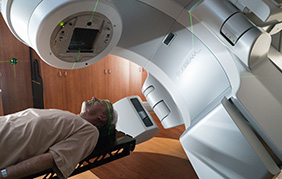Radiation therapy options
Radiation therapy for prostate cancer requires accuracy and precision. At City of Hope, our radiation oncologists use radiation therapies that precisely target tumors to destroy cancer cells, shrink tumors and provide relief of common prostate cancer symptoms.
Depending on your individual needs, you may receive radiation therapy alone or in combination with other medical treatments like surgery, chemotherapy, and/or hormone therapy. At City of Hope, radiation oncologists perform a variety of radiation therapy techniques, depending on your specific diagnosis.
External beam radiation therapy (EBRT)
EBRT is the most common type of radiation therapy used for cancer treatment. In this type of treatment, a special X-ray machine called a linear accelerator generates and aims radiation at tumors in the body. The patient lies on a bed beneath the machine, and the beam is directed at the cancer site.
Because the prostate may move during radiation treatment as a result of breathing and normal movement in the intestines, healthy tissue near the prostate may be affected. New technologies, such as the TrueBeam™ advanced linear accelerator that targets tumors with high precision, are designed to reduce the amount of radiation healthy tissue receives.
TrueBeam is often used in conjunction with the Calypso® 4-D localization system with Beacon® electromagnetic transponders, designed to reach specific tissue and monitor the position of the prostate during each treatment session. In most cases, EBRT is delivered in several sessions over the course of a few weeks.
The following are EBRT techniques City of Hope uses commonly to treat prostate cancer:
Intensity modulated radiation therapy (IMRT): IMRT allows radiation oncologists to improve the precision of treatment by shaping radiation beams to fit the contours of the targeted tumor. By sparing more of the healthy surrounding tissue, such as the bladder, bowel and rectum, doctors are able to deliver higher doses of radiation to specific targets. IMRT may be an option for patients with prostate cancer that has not spread as well as for patients with recurrent prostate cancer who have received radiation therapy previously.
Stereotactic body radiation therapy (SBRT): SBRT may be a treatment option for patients with early-stage prostate cancer. During this type of radiation therapy, doses of highly-focused radiation beams are delivered to the prostate. Typically, SBRT is delivered to a patient over the course of five days.
Internal radiation therapy or brachytherapy
This treatment delivers high doses of radiation using temporary implants placed close to or inside prostate tumors. When combined with EBRT to treat cancer, EBRT works to destroy cancer cells in the area surrounding the organ while internal radiation therapy delivers a high dose of radiation to the tumor inside it.
The two main types of internal radiation therapy treatments are:
High-dose rate brachytherapy (HDR): HDR delivers a high dose of radiation from implants placed inside the prostate over the course of a few minutes. HDR catheters carrying the radiation source are inserted into the prostate just before treatment is delivered and usually removed just after treatment is completed. Many times, HDR is delivered over a few days.
Low-dose rate brachytherapy (LDR): LDR delivers a low dose of radiation from seeds implanted inside the prostate. The LDR seeds remain inside the prostate, slowly releasing radiation until they are no longer active. This type of brachytherapy may be recommended depending on the type and stage of the prostate cancer.
SpaceOAR®
The SpaceOAR System may also be incorporated during radiation therapy for prostate cancer to reduce the radiation dose to the rectum. SpaceOAR is a temporary, injectable gel that creates a space between the prostate and the rectum. The gel stays in the body for about three months, and then is naturally absorbed and eliminated in the urine. By separating the prostate from the rectum and reducing radiation exposure, the gel is designed to reduce, or possibly eliminate, damage to the rectum and associated side effects.
